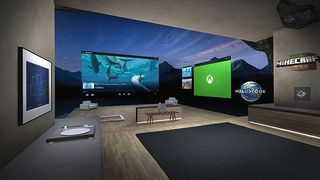Windows Mixed Reality Will Support SteamVR On Nov 15

Yesterday, a report surfaced that suggested that Microsoft and Valve would enable support for Windows Mixed Reality headsets on Valve’s Steam platform on November 15. Microsoft didn’t offer an official response when we pressed for confirmation, but sources with knowledge of the matter confirmed that it is true.
Microsoft launched its XR platform, Windows Mixed Reality, last month alongside the Windows 10 Fall Creators Update. WMR introduces a new way to interact with your Windows 10 environment and Universal Windows Platform apps. Rolling Stone’s report suggests that you would access the Steam VR platform through a UWP app that you must launch from the WMR home environment. Our source didn’t confirm that Steam VR for WMR would be a UWP app, but we believe that it is accurate. Windows 10 is largely built on UWP, and WMR gives Microsoft an opportunity to convince developers to embrace the universal app platform.
In our search for answers about WMR Steam VR Support, we learned that not everyone would be able to enjoy Steam VR games with a WMR headset. Microsoft supports two performance tiers for WMR-compatible devices. A basic WMR-compatible system requires a 7th generation Intel Core processor with an integrated graphics processor. We aren't surprised that a basic system won't support Steam VR games, but we didn’t expect that you’d have trouble with a system that meets the Windows Mixed Reality Ultra requirements.
Microsoft’s high-end hardware configuration, which enables the headset to operate at 90Hz, requires an Intel Core i5-4590 or AMD Ryzen 5 1400 processor. You’ll also need a somewhat powerful graphics card to meet the WMR Ultra requirements. Microsoft recommends a GTX 960 or GTX 1050 from Nvidia, or an RX 460 or RX 560 from AMD. It also supports mobile Nvidia GTX 965M GPUs.
Our source suggested that you’ll need a much more powerful machine to play Steam VR games through the WMR platform. We were told that you would need at least a GTX 1070 or equivalent GPU (Vega 56 comes to mind). We can’t say we’re surprised that you need a high-end GPU to play Steam VR games, but we were somewhat taken aback when we learned the CPU requirements. Our source suggested that you would need a 7th generation Core i7 processor to get the job done. We suspect that an 8th generation Core i5 would do the trick, but that remains to be seen.
Stay on the Cutting Edge
Join the experts who read Tom's Hardware for the inside track on enthusiast PC tech news — and have for over 25 years. We'll send breaking news and in-depth reviews of CPUs, GPUs, AI, maker hardware and more straight to your inbox.
Kevin Carbotte is a contributing writer for Tom's Hardware who primarily covers VR and AR hardware. He has been writing for us for more than four years.
-
Dyseman Shouldn't the title be SteamVR will Support Windows Mixed Reality Nov 15?Reply
I've been from PSVR and added Oculus as well as, last week, Lenovo WMR.
I have to say, WMR has better graphics, but less apps. I have grandkids and wife loves VR, so all 3 are in use. -
bit_user Reply
If the games were written to require a GTX 1060 or RX 480 on a 2160x1200 resolution HMD, it's only logical to assume they'll need commensurately faster graphics hardware to run at 2880x1440 (or 2880x1600 for Samsung).20363534 said:we didn’t expect that you’d have trouble with a system that meets the Windows Mixed Reality Ultra requirements.
Our source suggested that you would need a 7th generation Core i7 processor to get the job done.
I think it has to do with the fact that WMR is doing a lot of processing on the host PC (HMD tracking is a lot harder, if you've got no light houses or IR markers at fixed geometry). Perhaps Steam apps are granted exclusive use of the GPU, forcing the HMD tracking to go on the CPU. ...because I doubt just the additional layer of API overhead could account for that discrepancy.
Most Popular


